Life is absurd and other ideas from the arthouse Asteroid City (2023): meaning of the movie, explanation of the plot and ending, essence of comedy, similar movies.
Country: USA, Germany, Spain
Genre: arthouse, comedy, drama, fantasy
Year of production: 2023
Director: Wes Anderson
Actors: Jason Schwartzman, Edward Norton, Bryan Cranston, Adrien Brody. Scarlett Johansson and others.
Awards: Nomination for the Palme d’Or at the Cannes Film Festival in 2023.
Without changing his unique style, director Wes Anderson made a new film with a deepening into surrealism and absurdity – it seems, more than the previous ones. Not everyone has figured out the meaning of the film “Asteroid City”. Among the puzzled are the director’s devoted fans. Evil tongues say: the plot suggests that the script was written by a neural network. Let’s try to understand whether everything is really so complicated or whether the meaning lies on the surface.
What is the movie about
The film “Asteroid City” begins with the filming of a black and white television program. The presenter immediately makes it clear that all the events that will be shown below are fictitious and do not contain a clearly established and thoughtful hidden meaning. We are introduced to a playwright named Conrad Earp, who is writing a play. The action immediately moves to her rehearsal. The audience finds themselves in the center of the events of the work itself, which literally splashes with bright colors.
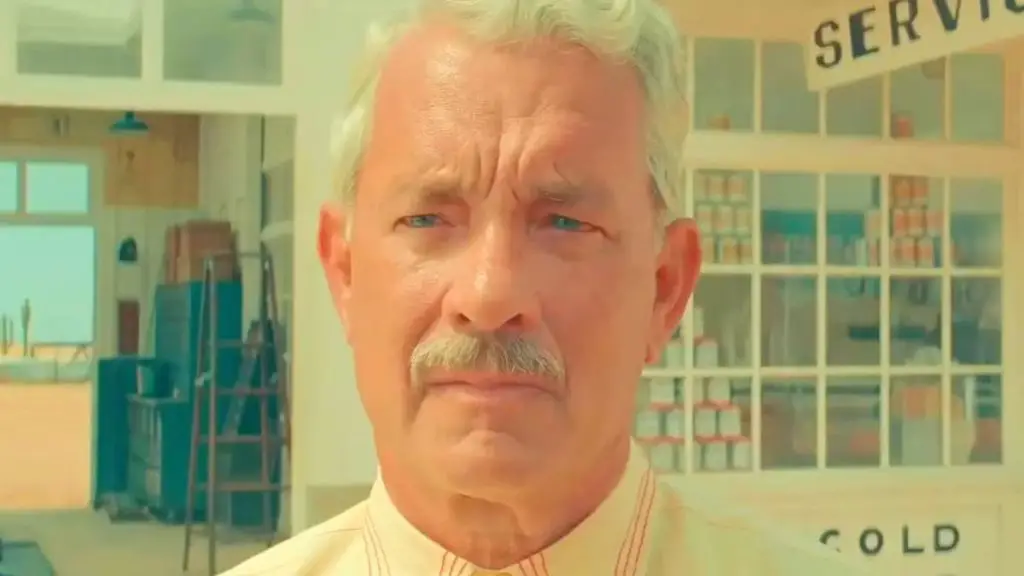
The play is set in September 1955. A train rushes through the middle of the desert, approaching the fictional Asteroid City. The locomotive carries useful goods, including food, building materials, machinery and livestock. One of the carriages even contains a missile with a nuclear warhead.
The cameraman takes a panorama of the center of Asteroid City. In addition to a number of buildings and structures, there is a billboard depicting a local landmark – a crater from a meteorite that fell five thousand years ago.
Photographer Augie Steenbeck arrives at a local gas station with his family – three daughters and teenage son Woodrow. Their conversation in a local cafe is interrupted by an explosion at a nearby nuclear test site. The mechanic tries to fix Oga’s broken car, but in vain. At the end of the inspection, the faulty part literally breaks out. It becomes clear that the family will have to stay here for a while.
The photographer contacts his father-in-law, Stanley, by phone. The men have a strained relationship, which was further aggravated by the death of Augie’s wife (and, accordingly, Stanley’s daughter). The children are not yet aware of the tragedy that happened. Augie asks his father-in-law to pick up the girls while he attends a meeting of young astronomers with his son.
The city is gradually filling with arriving guests. Among them: a group of elementary school students led by teacher June Douglas, actress Midge with her daughter Dina and many other interesting personalities.
Augie still informs the children about their mother’s death and shows her ashes. The presenter interrupts the action to talk about the choice of the actor for the main role. We are shown the intimate relationship between playwright Conrad Earp and actor Augie Jones Hall (who in turn is played by Jason Schwartzman).
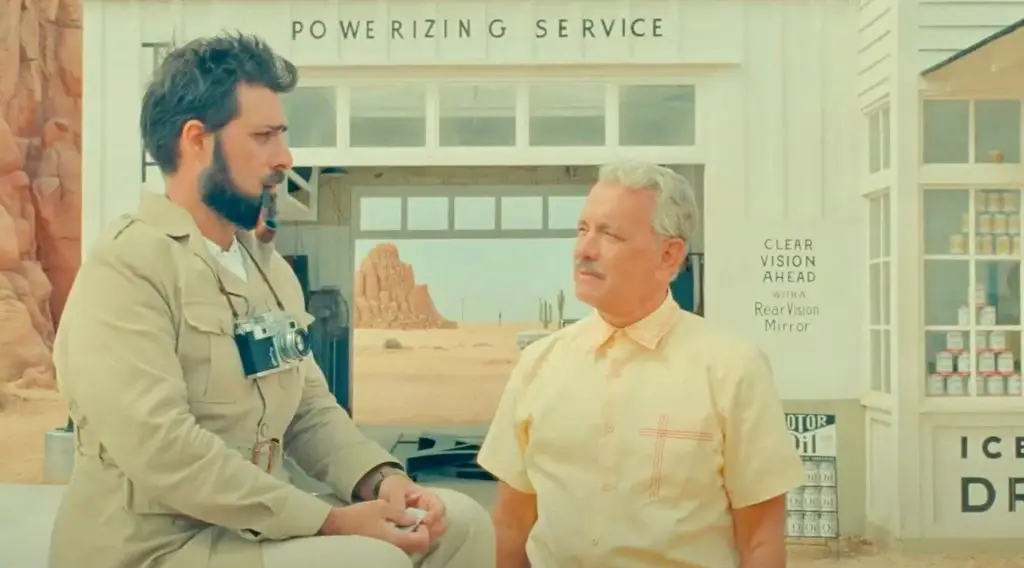
At the cafe, Augie and Woodrow meet Midge and Dinah. It turns out that the main character is a military photographer. He even shows off a shrapnel scar on the back of his head.
All arriving guests are solemnly greeted by the military man, making a speech. They are shown a fragment of that same meteorite and given a tour of the observatory. Children are given awards for their achievements in science. Woodrow was among those who distinguished themselves. At the observatory, he notices strange signals being received by the antennas. It turns out that they mean today’s date.
Adults and children at tables discuss various issues, including the existence of humanity and its loneliness in the universe. Woodrow communicates with other young talents.
In the black-and-white layer of “reality,” the actress playing Midge is persuaded to return to the production.
Children start a game that consists of creating a continuous chain of names of their idols. Teacher June discovers her pupil in the company of cowboys playing music with a cigarette in his hands and makes a remark.
Midge learns her character’s lyrics in the bathroom. Ogi starts a conversation with her from the window of a nearby building. The woman shows him her monologue, which takes place in the nude.
The motel owner explains to the cowboy leader how the machine that sells plots of land nearby works.
Oga’s daughters perform an impromptu funeral ritual, burying a box containing their mother’s ashes in the sand. Grandfather Stanley, who arrived in Asteroid City, finds them doing this. He proposes a “more serious” funeral in the backyard of his ranch.

Astronomer Dr. Hickenlooper speaks to the rally participants, talking about the upcoming celestial phenomenon. Participants wear cardboard boxes that supposedly help them watch the “eclipse” painlessly. However, something unexpected happens: a flying saucer hovers over the audience, from which an alien emerges and steals a meteorite fragment. The UFO flies away.
In black and white “reality” we are introduced to the director of the play, Schubert Green. His wife left him and since then he has lived in theater settings.
After the UFO incident, the city is cordoned off by the military. In addition to caring about the territorial integrity of the United States and preserving resources, they are concerned that the aliens might turn out to be communists. The military conducts various tests on the participants of the “contact” with extraterrestrial civilization. One of the main objectives of these activities is to prevent information leakage. However, curious schoolchildren are in no hurry to forget about the incident. Singing cowboy Montana tells them about the alien, comparing the alien to the native inhabitants of America.
Woodrow, Dina and Dr. Hickenlooper spend time at the observatory. Parents of teenagers continue to communicate through the windows of their houses opposite. Their conversation is interrupted by Stanley, who, as it turns out, knows the actress’s agent.
The motel owner continues to sell plots of land.
Midge’s conversation with a fan is interrupted by the appearance of a presenter from the black and white “layer.” Realizing that he was not where he should be, he leaves the frame.
Augie and Stanley discuss the girls’ future. Stanley, despite his antipathy towards his son-in-law, offers the family to stay with him. But Woodrow is more concerned about the alien’s visit.

One of the young talents asks the military man to throw a coin into the telephone machine, supposedly to pay for yesterday’s conversation. However, this turns out to be a ploy by the children to contact friends outside of Asteroid City via a wired line and report the sensation to them.
In a black-and-white “layer,” director, playwright, and acting teacher Salzburg Keitel discuss how best to stage a scene about an alien visit to Asteroid City.
As a result of the children’s actions, the whole country learned about contact with aliens, and Augie’s photograph of the alien adorns the newspapers. The general threatens the teenagers with punishment, but everything has already gotten out of control.
Cowboy musicians and children compose a song and dance dedicated to the alien.
Augie and Midge continue to communicate, exchanging photos and scripts. The couple discusses how Dina caught them together. Midge is also worried about the appearance of an alien. It seems to her that he looked at people as if they were doomed.
The military’s siege of Asteroid City continues, leading to conflict between them and the civilian population. The general’s assistant, however, manages to hush him up.
The children plan to establish contact with an alien civilization. Dr. Hickenlooper supports them.
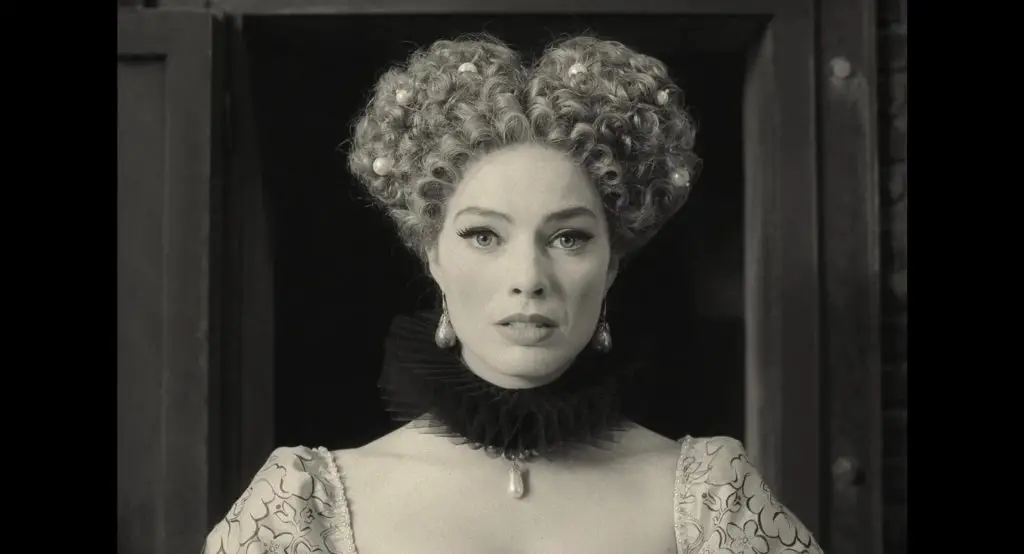
Finally, the military solemnly announces the end of quarantine. At the height of the ceremony, the flying saucer again hovers over the people. It turns out that the alien took a meteorite fragment to inventory it, putting marks on it. Now the deed is done and the “thief” returns the “stolen”. The military announced quarantine again, but people rebelled.
Augie, not understanding what is happening, goes beyond the scenery and in the black and white “layer” again becomes the actor Jones Hall. He does not understand the plot and meaning of the play, and his character. But the director insists that everything is going as it should. The actor goes out onto the balcony to smoke. There he communicates with the actress standing on the opposite balcony, who played the deceased wife of his character. This role was cut, but the photograph is still used in the production. The actors recall the deleted scene. Jones-Augie is informed that they are waiting for him on the site, and he leaves.
The presenter says that six months after the premiere of the play, the playwright died in a car accident. The last part of the production was never completed.
An alien suddenly appears at a rehearsal.
In Asteroid City, Augie discovers that most of the guests have left. The quarantine was lifted after all. Oga’s family decides to leave the ashes of the deceased at the site of an impromptu burial.
Midge gives Augie her mailing address, along with him leaving hope for a further romantic relationship.
At the end of the film, another nuclear explosion is heard. The family leaves Asteroid City.
The meaning of the film Asteroid City
The content of Asteroid City is replete with references to post-war US history, as well as the history of cinema and theater. Those who wish can delve deeper into them. We can try too, but putting together a complete set is probably only possible for those who are already familiar with all this quite deeply. So let’s try to go the other way – to express the essence of the film through the peculiarities of its plot. After all, the point is not in the references, despite their abundance. This is rather a pleasant addition for connoisseurs.
So, in direct text, the audience is given an explanation of the three-layer nature of the picture. According to the proposed description, this is a story within a story and also within a story. Here, actors play actors who play characters. The first “layer” is US television of the late fifties (the host here is a kind of interpretation of the leading anthology series “The Twilight Zone”; the whole setting refers to the programs of that era). The second is the US theater of the same time (essentially a mixture of European and American theater schools). Both “layers” are black and white with a classic TV screen size. The third is the play “Asteroid City” itself, taking place in the same conventional fifties. Everything in it is imbued with the spirit of retro-fiction, referencing the cult figures of Breedbury, Clarke, Asimov…
Why such a division? First of all, this is one of the director’s favorite moves – “multiplicity” of history. You could say it’s part of his style. In the context of Asteroid City, it is justified by the absurdity of what is happening – the viewer is constantly reminded that all this is not serious. The observer is encouraged to go beyond the boundaries of the narrative and, in a sense, beyond the boundaries of his own perception.
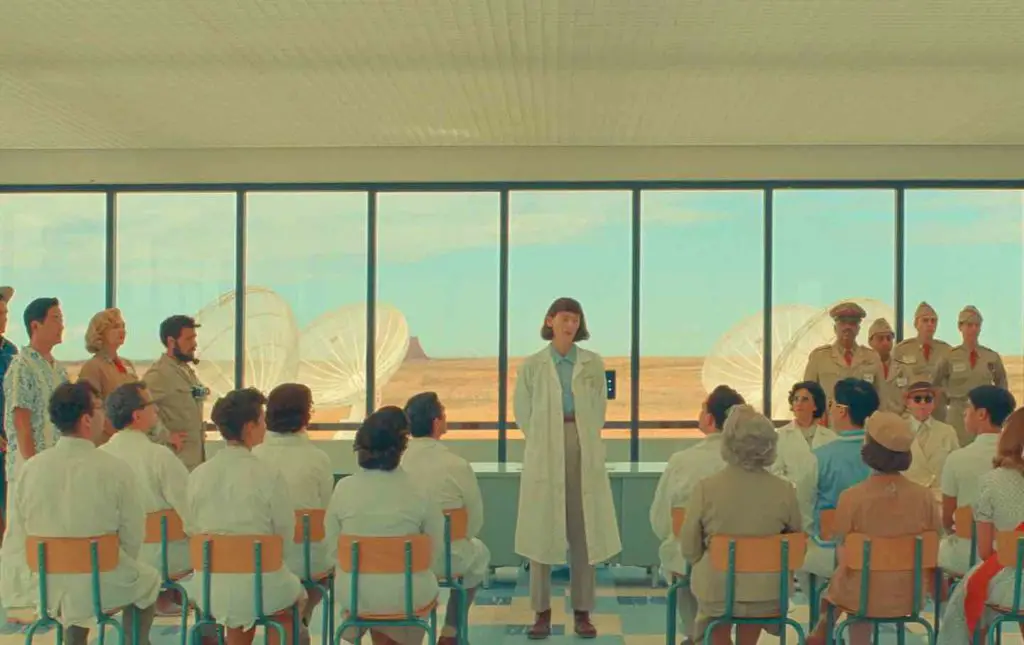
Another way to place the viewer not “inside” but “outside” the action is through “superficial” acting. Let us note that all the stars present in the frame, one might say, do not use their talent – they literally do not act, but more often they simply pronounce their text. Such unemotionality does not allow one to immerse oneself in the feelings and actions of the characters, but allows one to dissect them, as it were, to examine them from the outside.
And there are many characters in the play that we are asked to analyze. The greatest emphasis is placed on Augie. He is traumatized by the death of his wife – figuratively (the authors hint that the character’s tragedy is due to tragic events in the life of the playwright and director). And he was injured at the front – literally. Life is broken (it is personified by a broken car from the “former life” of the hero’s family).
Having lost a loved one, Augie finds himself in a kind of void. The emptiness is personified by the local desert landscape. Another hint: the gaping crater on the advertising poster. Other characters are also dissolved in this emptiness – some also due to mental trauma (like, for example, Midge, who clearly suffered from an abusive relationship), some because, figuratively speaking, they themselves are a dummy.
The latter are the majority in the play – and this is a stone (if not a “meteorite”) in the garden of American society of the fifties, blindly following trends that are now clearly assessed as rather stupid. Here, anti-Soviet paranoia blooms wildly (remember the funny remark about a non-communist alien), fear of nuclear war (again, elevated to tragicomic absurdity: here no one is embarrassed by the nuclear explosions occurring very nearby), obsession with the newfangled theme of UFOs. To all this, the director adds criticism of capitalism (for example, selling land through a machine) and colonialism (for example, comparing aliens with Indians).

Analysis of conventionally deep characters and conventionally dummy characters provides food for thought, but does not answer the question: what is the point, what is the main idea? The actors themselves are struggling with the solution. So, Jones Hall does not understand at all how to play the role of Auggie, and is trying to find out the director’s interpretation. The same one simply tells us not to worry, because everything is going as it should.
Here lies the main absurdity: something very strange is happening and, perhaps, very important both for the actors and for their characters. But people just live: go about their business, build relationships, and from time to time try to learn the secrets of the universe. And globally their actions do not affect anything. Everyone lives their life, which is equivalent to playing their characters or watching a dream.
Absurdity, in general, is the whole point of Asteroid City. The exclamation that everyone repeats in acting school (“You can’t wake up unless you sleep,” which is akin to “You can’t live unless you’re born” or “You can’t die unless you live”), which is heavily emphasized , just refers to the theater of the absurd.
There, as in this film, the authors introduce the audience into a certain uncomfortable state caused by the illogicality of what is happening. And there is only one way out of it – to accept everything as it is. In other words: accept a life in which there is a place for losses and gains, big and small events, comical and tragic incidents. In addition, there is hope to someday find out the “end of the play” (remember that it was not completed due to the death of the playwright), where its meaning – the meaning of life – will finally be explained to us.
Asteroid City Movie Ending explained
The meaning of the ending of the film “Asteroid City” is the same combination of the theater of the absurd and acceptance as a way out of it. Augie and Woodrow accept the death of their wife and mother and are ready for a new relationship, which has already begun here. Stanley has come to terms with the “will of his granddaughters” and is also ready to move on. The family goes on its way. The entire American society of the fifties, which personifies “Asteroid City,” accepts the strange visits of the alien and the commotion associated with him and simply continues to live the same life – the same habits and prejudices. The explanation of the ending is quite in the spirit of Wes Anderson’s filmography.
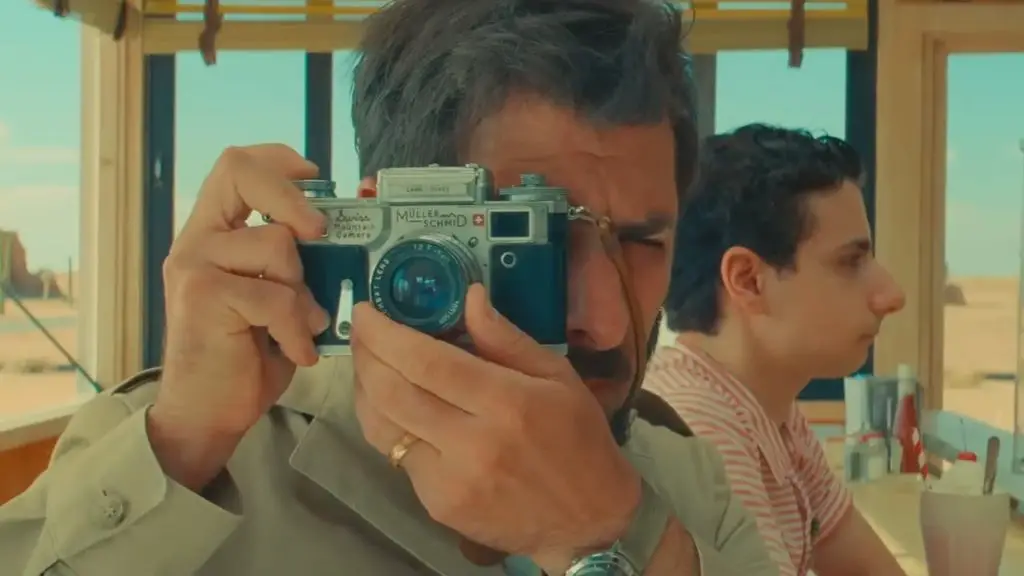
Similar films
- “Moonrise Kingdom” (USA, 2012): one of the best films in Wes Anderson’s filmography;
- “The Grand Budapest Hotel” (USA, Germany, 2014): another masterpiece by Wes Anderson;
- “October Sky” (USA, 1999): the story of a dream come true in the United States of the late fifties;
- “Once Upon a Time in… Hollywood” (USA, China, UK, 2019): an alternative history of Hollywood in the seventies with a huge number of references to real history and cinema;
- “Dogville” (Denmark, Sweden, the Netherlands, 2003): another synthesis of film and theater play, but in a dark and creepy presentation by Lars von Trier.







